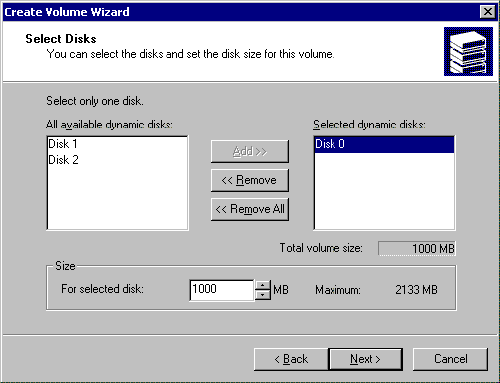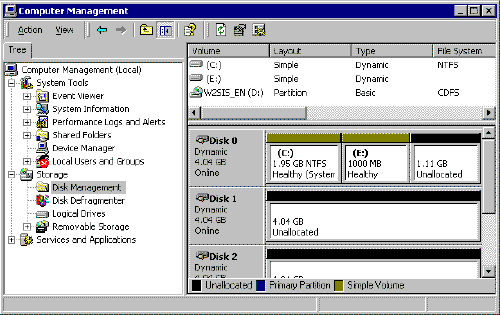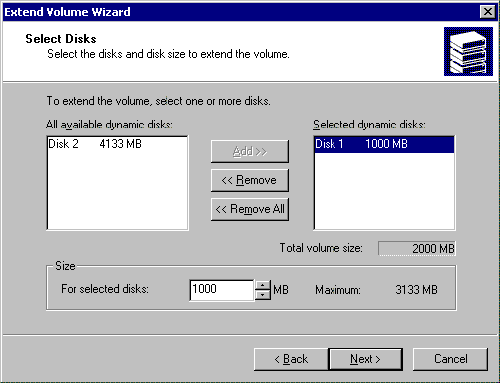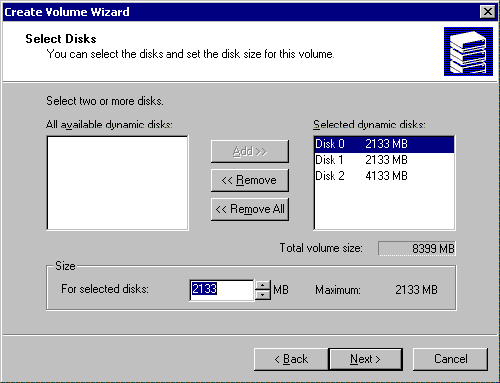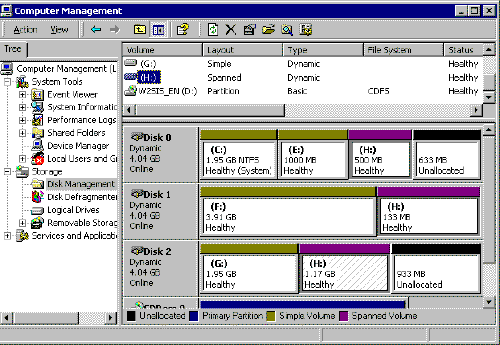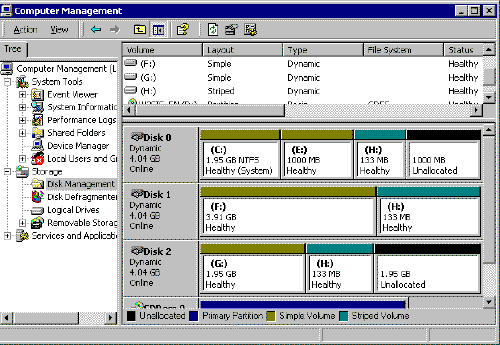When working with dynamic disks, you can create simple volumes using DiskPart . This is the basic type of dynamic volumes. Unlike partitions, a simple volume can occupy the entire disk or a desired part of it.
Creating Simple Volumes
Before adding a simple disk volume, you should determine the amount of free disk space and view the current volume configuration. To do this, perform the following operations.
- List disks and check free space on them
After selecting the desired disk, you can create a simple volume with the command:
- create volume simple size=N disk=N
where size^N is the size of the volume in MB, and disk=N specifies which disk the volume will be created on.
After creation, the volume automatically receives focus, i.e. becomes selected. The volume does not yet have a drive letter or mount point. To assign them, you need to issue the ASSIGN command. Then, to complete the preparation of the volume, format it with the FORMAT command (standard external Windows team, not a DiskPart subcommand). These operations are the same for volumes and partitions.
Expanding Simple Volumes
If you find that you are running out of space on a simple volume, increase its size in one of two ways. The first is the expansion of a simple volume within the same disk, resulting in the creation of an extended volume. And the second is the expansion of a simple volume with distribution to other disks; then you will get a covered volume. In any case, the volume must be formatted as NTFS.
To expand a simple volume, follow the steps below.
- Enter diskpart in command line to start DiskPart.
- List the disks and see the amount of free space on them:
- DISKPART> list disk
- List volumes: DISKPART> list volume
- Select the volume you are going to expand, for example volume 5:
- DISKPART> select volume 5
- Expand volume.
Create a new simple volume
On dynamic disk You can create an unlimited number of volumes, but the number should suit your needs. Because each volume behaves like an independent physical disk, you can create storage volumes various types information. A simple volume, which is a single block of disk space, does not contain other volumes or disks. As is the case with many other components operating system, creating volumes in Windows 2000 is a wizard-based process and is a simple task. To create a new volume on a dynamic disk, follow these steps:
| 1. | open Control Panel, go to Administration (Administrative Tools) and double click on the icon Computer Management. In the left pane of the window that opens, select . |
| 2. | Select the desired area of unallocated space on the disk, in the menu Action go to point All Tasks and select command Create Volume. Figure 10-1 Using the Action menu to create a new volume |
| 3. | Next. |
| 4. | In the window shown in Figure 10-2, Simple Volume and press the button Next.
Figure 10-2 - Select a simple volume and click Next |
| 5. | The disk you selected will be displayed on the right side of the window. Select Disks as shown in Figure 10-3. You can specify another drive (if your system has more than one drive installed) using the buttons Add, Remove And Remove All. For creating simple volumes only one disk is used. The same window displays the maximum possible size of the future volume in megabytes. You can specify the desired value in the field Size and then press the button Next.
Figure 10-3 - Select the desired disk and specify the volume size in this window |
| 6. | The drive letter for the volume will already be listed in the window, but you can assign a different drive letter by selecting it from the drop-down list. Here you can also mount the volume to an empty NTFS folder, which is discussed in more detail in the next section. You can also choose not to specify a drive letter or path at all at this stage. Once you have made your choice, click the button Next. |
| 7. | In the window shown in Figure 10-4, you can choose whether to format this volume. If you decide to format, use the drop-down lists to select the desired file system and cluster size (the latter can simply be left by default). You can also assign the desired volume label in the corresponding text field. In addition, at this stage, you can choose to quickly format the volume, as well as specify whether the volume will be compressed files and folders to save space. These options can be set by checking the appropriate checkboxes. Compression is discussed in more detail in Chapter 17. After making your selection, click the button. Next.
Figure 10-4 - Select formatting options and click Next Brief reference. All file systems used by the Windows 2000 operating system organize work with hard drives based on cluster size. The cluster size is the minimum possible amount of disk space that can be allocated to store a file. This approach ensures efficient use of free disk space and prevents fragmentation. If you don't specify your own cluster size, the operating system will do it on its own based on the size of the volume. Quick format deletes all information hard drive, but does not check for the presence bad sectors. If you don't have new disk, it is better to do full formatting, thereby allowing the operating system to perform a thorough check of the disk. |
| 8. | In the final window of the wizard, click the button Finish. The created volume will be displayed in the snap-in Disk Management as shown in Figure 10-5.
Figure 10-5 - New volume successfully created |
Attaching a simple volume to an empty folder
operating room Windows system 2000 has new opportunity, extending the drive letter management functionality. Previously, primary and secondary partitions on a basic disk were assigned letters on an alphabetical basis (C, D, E, F, etc.). Of course, this limited the freedom of choice to twenty-six letters of the alphabet. In Windows 2000, this limitation can be overcome by using a completely new way of naming volumes. The method is based on connecting the volume to an empty NTFS folder. The volume you create is mounted to a folder located on another local NTFS volume, but the new volume can be formatted with any file system supported by Windows 2000. This effect can be achieved by using a drive path instead of a drive letter, which is best explained with an example. Let's say you want to create a "Documents" volume to store documents. In addition, you need the volume to appear on the C drive and not on its own drive. You simply mount the volume to an empty “Documents” folder, which is located on the C drive formatted with the NTFS file system. As a result, the new volume appears as C:\Documents rather than as a separate volume. This feature, specially designed for more flexible disk management, provides a number of advantages beyond the connection of dynamic volumes. For example, you can connect an optical disc (CD-ROM) to drive C so that it appears as C:\CD-ROM, thus creating an attached drive. Translator's note. In some sources, connecting a volume to an empty folder is called a mount.
To mount a volume, you must have an empty folder on the drive (for example, drive C). Do not forget that the folder must be created on a volume formatted in the NTFS file system. Subsequently, the volume you create can be formatted with any file system supported by Windows 2000.
You can mount a volume to an empty folder using the Create Volume Wizard in the snap-in Disk Management. In the window Assign a Drive Letter or Path set the switch to position Mount this volume at an empty folder that supports drive paths instead of a drive letter, as shown in Figure 10-6.
Figure 10-6 Connecting a volume to an empty folder
Then enter the path to the folder or click the button Browse. In the second case, you can select the desired folder on the disk in the dialog box. In addition, you will be able to create a new folder if this was not done before starting the wizard. After selecting a folder as shown in Figure 10-7, click OK and then button Next to continue the wizard.
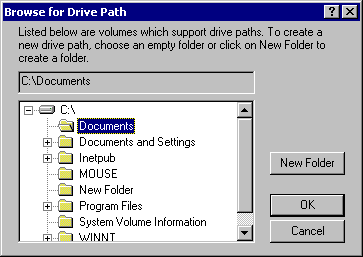
Figure 10-7 - Use the Browse button to select an existing folder or create a new one
After the wizard finishes, open the volume where the folder is located with the new volume attached to it. In the Explorer window ( windows explorer) the mounted volume will be displayed as a "disk within a disk", as illustrated in Figure 10-8. Connecting a volume to an empty folder allows you to simplify access to data stored on hard drives, which you will see more than once using this feature in practice.
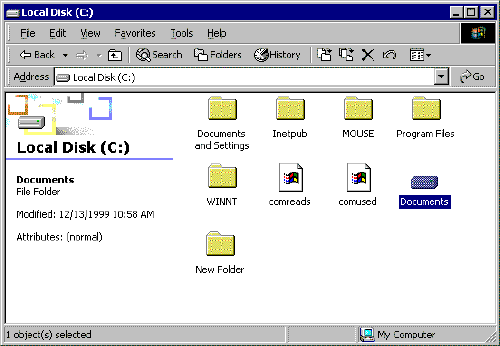
Figure 10-8 - The mapped drive is displayed in the specified location
Volume expansion
By creating a simple volume, you can later increase the disk space it occupies if there is still free space on the disk. The volume can be easily expanded without risking losing the data stored on it, even without restarting the computer. For example, Figure 10-9 shows a simple volume F. As part of Disk 1, it occupies 1 GB of disk space. On the first disk, another 3.06 GB is available as unallocated space. With the help of equipment Disk Management you can easily expand volume F up to 2 GB.
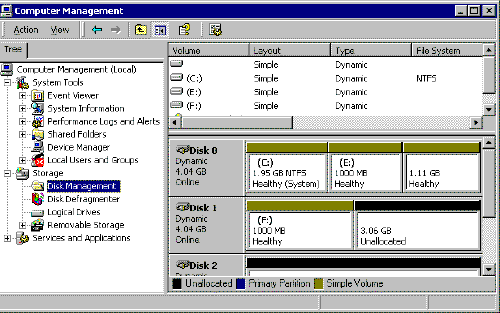
Figure 10-9 - Volume can be expanded
To expand the volume, open the snap-in Disk Management, highlight the desired volume, in the action menu Action go to point All Tasks and select a command. The Extend Volume wizard will open, in which you will need to perform the following steps.
| 1. | In the first dialog box of the wizard, click the button Next. |
| 2. | In the window Select Disks make sure you work with desired disk, and in the field Size enter the desired number (in megabytes) by which you want to extend the volume. Then press the button Next to go to the last window of the wizard.
Figure 10-10 - Specify the size of the extension and click the Next button |
| 3. | Click the button Finish to complete the wizard. An extended volume retains its drive letter, as shown in Figure 10-11.
Figure 10-11 - The extended volume is displayed in the Disk Management snap-in |
Create spanned volumes
Spanned volumes, known in Windows NT as volume sets, allow you to combine areas of free, unformatted space into a single logical drive. For example, you might have three hard drives, each with 1 GB of raw space. You can combine these three areas into one 3 GB logical drive. This solution makes it possible to efficiently manage the remaining disk space, but does not increase fault tolerance. If any of the three disks fail, all data on the spanned volume will be lost. Also, deleting part of a spanned volume results in the loss of the entire volume. However, spanned volumes are a good solution for efficient use of unallocated space on different disks. You can merge from 2 to 32 dynamic disks, and the merge areas can be of different sizes. In other words, one drive might have 1 GB of unallocated space, while another might have 500 MB of free space. After you combine disparate areas into one composite volume, the Windows 2000 operating system will treat it as a single unit.
You can later add free space areas from other disks to an already created spanned volume, provided that the volume is formatted in the NTFS file system. However, removing any of the parts will result in the loss of the entire volume.
Brief reference. The Windows 2000 operating system has features that provide fault tolerance and protect your data in the event of a single hard drive failure. The solution is based on the use of several hard drives. Even though a spanned volume uses at least two hard drives, this solution is storage-oriented, not fault-tolerant. Data on a spanned volume is not immune to hard drive failure and will be lost if it fails.
Follow these steps to create a spanned volume:
| 1. | Action go to point All Tasks and select command Create Volume. |
| 2. | In the Create Volume wizard window that appears, click the button Next. |
| 3. | In the window Select Volume Type set the switch to position Spanned Volume and press the button Next. |
| 4. | In the window Select Disks Add. The disks will be displayed in the window for the selected disks, as shown in Figure 10-12. In field Size for each of the disks, you can specify the amount of free space that will be used in the spanned volume. After making your selection, press the button Next.
Figure 10-12 - Select the desired drives and click the Add button |
| 5. | In the window Assign a Drive Letter or Path assign a drive letter to the spanned volume, or mount it to an empty NTFS folder. Then press the button Next. |
| 6. | In the window Format Volume specify whether the operating system should immediately format the spanned volume. If you choose to do so immediately, select the desired file system, set the cluster size, and set the volume label. Click the button Next. |
| 7. | Finish. A spanned volume will be created and displayed in the snap-in Disk Management with a purple stripe above the volume letter or name, as shown in Figure 10-13.
Figure 10-13 - Spanned volume is displayed in the Disk Management snap-in |
Create striped volumes
Another solution for storing data across multiple hard drives is a striped volume (known in Windows NT as a striped set). As in the case of a spanned volume, unallocated areas of physical disks can be combined into a striped volume, the number of which can vary from 2 to 32. However, the operating system writes data in the form of ordered blocks of the same size to all disks that are part of the striped volume at once. Therefore, unallocated areas on disks must also be the same size. The Create Volume Wizard will help you create striped volumes, which does not allow you to merge unequal areas of free disk space into a striped volume. Let's say you have three hard drives. One drive has 500 MB of free space, and the other two have 1000 MB. You can use up to 500 MB from each disk for a striped volume, and the maximum volume size is thus 1.5 GB (however, you can use smaller areas of disk space).
As with spanned volumes, striped volumes are not designed to improve fault tolerance. If any disk fails, all data on the striped volume will be lost. However, compared to spanned volumes, striped volumes provide more high performance. They have top speed write and read data among all disk management solutions in Windows 2000. Due to the nature of writing data to a striped volume, it cannot be expanded.
To create a striped volume, follow these steps:
| 1. | Select the desired area of unallocated space on the disk, in the action menu Action go to point All Tasks and select command Create Volume. |
| 2. | In the Create Volume wizard window that appears, click the button Next. |
| 3. | In the window Select Volume Type set the switch to position Striped Volume and press the button Next. |
| 4. | In the window Select Disks select the disks you want to include in the spanned volume and click the button Add. The disks will be displayed in the window for the selected disks, as shown in Figure 10-14. For each disk, you can specify the amount of free space that will be included in the striped volume. This can be done by selecting the disk and changing the value in the field Size. Note that the maximum value is determined by the size of the smallest unallocated area of all included in the striped volume. Click the button Next.
Figure 10-14 - Select the desired drives and click the Add button |
| 5. | In the window Assign a Drive Letter or Path assign a drive letter to the striped volume, or mount it to an empty NTFS folder. Then press the button Next. |
| 6. | In the window Format Volume specify whether the operating system should immediately format the spanned volume. If you decide to do this right away, select the desired file system, set the cluster size, and set the volume label. In addition, at this stage, you can choose to quickly format the volume, as well as specify whether the volume will be compressed files and folders to save space. Click the button Next. |
| 7. | To complete the wizard, click the button Finish. A striped volume will be created and displayed in the snap-in Disk Management as a single volume, as shown in Figure 10-15.
Figure 10-15 - Striped volume appears as a single volume |
Common Volume Actions
One of the most significant advantages of the Windows 2000 Professional and Server operating systems is the flexibility of customization. Most of the most important configuration parameters can be changed repeatedly without risking system failure. Volume configuration is no exception to this rule. To perform various actions on the created simple, spanned, or striped volume, select it in the snap Disk Management and from the menu Action go to point All Tasks. The available actions are listed below:
| Open. This command opens the volume and allows you to navigate through its folders and files. | |
| Explorer. As in the previous case, this command opens the volume, but this time in Explorer for easier navigation through the volume's folders and files. | |
| Extend Volume. This command is used to expand simple and spanned volumes using a wizard (see the "Expanding a Volume" section earlier in this chapter for details). | |
| Change Drive Letter and Path. You can use this command to change a volume's drive letter or path, and to assign these options if you didn't do so when you created the volume. | |
| Format. If you didn't format when you created the volume, or you just want to format the drive, you can use this command. It allows you to specify a volume label, select a file system, assign the desired cluster size, as well as perform a quick format and apply compression to folders and files on a volume. If data is stored on the volume, it will certainly be lost during formatting. | |
| Reactivate Volume. You can use this command to try to remount a disconnected volume (see Chapter 11 for more details). | |
| Delete Volume. This command deletes the volume along with all its contents. | |
| Properties. This command opens the volume properties, which are discussed in the next section of this chapter. |
Dynamic volume states
As with online and offline drives, each volume can be in a specific state. The list of volumes is presented in the Disk Management snap-in. In the right top panel the volume label is displayed, and Additional Information about it: location, type, file system, state, capacity and free space. Column Status carries information about the disk, and depending on its state, the following information may be displayed there:
| State Healthy is the normal state of the volume when it is available and no errors are detected. | |
| Able Healthy (At Risk) The volume is accessible, but there are input/output (I/O) errors on the disk. The disk on which such a volume is located is in the . As a rule, the disk can be returned to the state Connected (Online) by reactivating it. To do this, right-click on the disk and select the command from the context menu. Reactivate Disk. | |
| Able Initializing the volume is being initialized, and after it is completed, the status of the volume will change to Healthy. No action is required from the user while the volume is in the initialization state. | |
| State Resynching on mirrored volumes means that a resynchronization is taking place between the two disks. After its completion, the volume will return to the state Healthy without any action from the user. | |
| State Regeneration occurs for RAID-5 volumes when information is regenerated based on parity data. RAID-5 volumes are discussed in more detail in Chapter 11. | |
| The volume may be in the state Failed Redundancy when the drive containing the volume is offline. In this case, the data is not provided with fault tolerance, both on mirrored volumes and on RAID-5 volumes. To avoid data loss, the volume must be restored. RAID-5 volumes are discussed in more detail in Chapter 11. | |
| State Failed Redundancy (At Risk) similar to the state Failed Redundancy, however, the disk on which such a volume is located is usually in a state Works (errors) (Online (Errors)). To correct errors, you must re-activate the disk so that it goes into the state Works (Online). | |
| State Failed occurs when the volume failed to start. You need to restore such a volume. |
Configuring volume properties
The volume properties dialog box shown in Figure 10-16 can be opened from a snap-in Disk Management by right-clicking on the volume and selecting Properties from the context menu. The window contains several tabs that allow you to configure various volume settings. More about them will be discussed below.
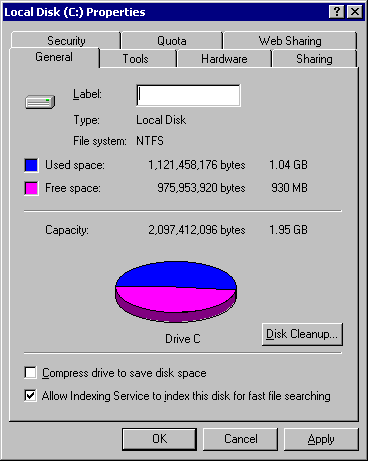
Figure 10-16 - Volume Properties
| On the tab General displays various information about the volume: the amount of free and used space, the file system, and the total capacity. On the same tab, you can change the volume label, run the disk cleanup utility, and enable disk compression to save space. | |
| tab Service (Tools) is designed to run utilities for checking the volume for errors, defragmenting the volume and archiving the files stored on it. This is covered in more detail in Chapter 13. | |
| On the tab Hardware a list of such elements is presented hardware, How hard disks, floppy disk drives and optical discs(CD-ROM and DVD-ROM), as well as other media related to disk and volume management. From this tab you can run a diagnostic Windows utility or open the properties of individual devices. | |
| On the tab Security (Sharing and Security) You can open general access to that and configure the necessary permissions. | |
| tab Quota is for configuring disk space quotas for a volume, which is discussed in more detail in Chapter 17. | |
| On the tab Web Access (Web Sharing) you can configure access to the volume through a Web site (for example, an Intranet site), allowing network users to work with the volume located on your computer. |
Conclusion
In Windows 2000, dynamic disks allow you to perform a number of disk management tasks. You can create any number of volumes on a physical disk, and even mount these volumes to empty NTFS folders instead of assigning a drive letter. You can format volumes with NTFS, FAT, and FAT32 file systems (NTFS is preferred). The use of dynamic volumes allows you to create spanned and striped volumes on systems where multiple hard drives are installed. This gives additional features for data storage and management.
Questions and answers
The questions and answers in this section will help you solve problems or test your knowledge of the material in this chapter.
Why can't I create a volume on my hard drive even though I'm on a Windows 2000 computer?
Your disk needs to be converted to dynamic. Because volumes can only be created on dynamic disks, you must first perform the conversion before you can create and manage dynamic volumes.
What file systems can be used when working with volumes?
The Windows 2000 operating system supports NTFS, FAT, and FAT32 file systems. Undoubtedly, the best choice is NTFS, so you must have a good reason to format the volume as FAT or FAT32.
Should I use a quick volume format?
A quick format deletes data from the volume, but does not scan the drive for bad sectors. As a general rule, it is not recommended to use a quick format (except when you have a new drive). Even though full formatting takes longer, it's best to give Windows opportunity to check the disk and repair bad sectors during the formatting process.
What is the point of attaching a volume to an empty folder?
Mounting a volume to an empty folder allows you to use the name of the folder for its name, rather than just a drive letter. This feature allows you to bypass the limitation associated with the number of letters (26) in the Latin alphabet, and assign "real names" to disks and volumes instead of drive letters.
Do free disk space areas have to be the same size when creating spanned volumes?
No. To create spanned volumes, you can use unallocated areas of any size located on disks, the number of which can vary from 2 to 32. Spanned volumes are filled with data in order, i.e. first, the data is written to the first volume until it is full, then to the second, and so on. Due to the peculiarities of the recording method, the sizes of the areas of free unallocated space do not matter. In the case of striped volumes, the unallocated areas on the disks really need to be the same size. This is due to the fact that data is evenly written to all disks at once.
Can I remove a single disk from a spanned or striped volume without risking data corruption?
No. If any drive is removed, all data on the spanned or striped volume will be lost (the same will happen if the drive fails).
about the author
Curt Simmons has worked with Windows 2000 Server since the release of Beta 1. As an author and technical instructor specializing in operating Microsoft systems, BackOffice products and Internet technologies, he has written over ten technical books and teaching aids. Simmons, who lives in Dallas, Texas, is a Microsoft Certified Systems Engineer (MCSE) and a Microsoft Certified Trainer (MCT).
We hope that the information in this article will be useful to you. However, you use the information provided in this article at your own risk. All information in this article is provided "as is" without warranty of any kind, express or implied, as to its accuracy, completeness, suitability for any purpose that conveys or infringes proprietary rights; Microsoft does not endorse, and does not author, represent, or warrant the information or third-party products mentioned in this article. Microsoft is not responsible for any damages resulting from the use of this information, including direct, indirect, special, incidental or consequential damages, even if Microsoft was advised in advance of their possibility. All product prices mentioned in this article are subject to change without notice.
Basic disk is the drive that is recognized old systems(Dos, Win 9.x, NT4). You cannot change the structure on this disk without rebooting. It contains up to 4 sections and has the structure:
Hardware table contains information about the physical structure of the disk: breakdown into sectors, the number of bad and good ones, their location...
MBR (Master Boot Record) - disk partition table. It contains information about disk partitions: their location and size, type, activity...
extended section– there can be only one on the disk. It can be divided into logical drives (up to 32 theoretically, but in reality - how many letters are enough). It may not be on disk.
Primary section - can be from 1 to 4 (most often 1). If there is Extended, then no more than 3. there should be no more than 4 partitions on the disk. From this partition, the operating system is loaded, the bootloader of which is located on this partition. Each Primary partition can have different operating systems, but only one will boot, the partition of which will be active.
boot sector- contains the program for the initial launch of the boot files of the operating system located on this partition.
Dynamic Disk: implemented only in Win2000. It contains only one partition divided into volumes. The advantage of such a disk is the ability to change its structure dynamically without rebooting the system, which is very important for server platforms. You can dynamically delete, create, and expand volumes.
Volumes on a dynamic disk can be:
Simple - simple (like partitions on a basic disk)
Spanned - composite (set of volumes)
Stripe - Striped (RAID 0)
· Mirror - mirror (RAID 1). Removing one mirror - remove, breaking a mirror -break
interleaved with parity (RAID 5). If one of the disks is damaged, it will be marked as corrupted and the data will continue to be written without parity. To recover, you need to replace the drive and reactivate. No reboot needed.
Dynamic volume is created by converting the base disk:
computer management - Disk management- context menu on disk - convert to dynamic
Reverse transformation only an unpartitioned disk is possible (i.e., before converting, you need to delete all volumes and data on them)
Install Win200 can only to a basic disk and then convert to dynamic
dynamic volume supports file systems -FAT, FAT32, NTFS.
Simple volume - it is one contiguous area on the disk. Up to 32 simple volumes can be created on a single physical disk. Each volume can be formatted with its own file system (FAT, FAT32, NTFS). Each volume can have a letter or be mounted to a folder (we'll look at this later). In fact, it is an analogue of a partition or a logical disk on basic disks. To create a simple volume, you need:
- allocate free disk space
- Call the context menu - Create Volume - Simple Volume
- then set its size, letter or mount to a folder, file system type, if formatting is performed immediately, ...
Composite volume - It is a collection of simple volumes on one or more physical disks. It is created from several free areas on several physical disks. These free areas are merged into one logical disk, which has a size equal to the sum of the sizes of all free areas in the set. This allows, for example, to write very big file, which would not fit into any single area.
In total, up to 32 free areas can be combined.
So the composite volume is:
· will only be available in Win 2000 and later.
cannot contain systemic or boot partitions Windows (at boot time, no one knows anything about it yet, because only the already loaded Win2000 system can work with it)
It does not have a failover system
The area is filled sequentially by two, while there is free space
· created in Disk Administrator- - Create Volume - Spanned Volume. Next are selected physical disks and the size of the areas on each of them. After that, the steps are similar to those for creating a simple volume.


